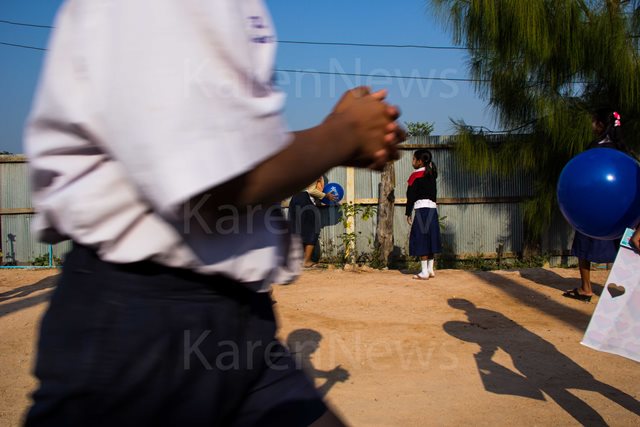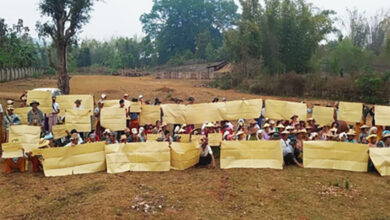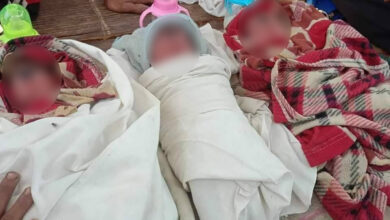Migrant Schools Offer Hope

Migrant schools working in Thailand’s border town of Mae Sot are bringing hopes of a better future for students, many of whom face huge challenges in just trying to survive.
“Last Sat…tehr…day! They went to the stay…di…um! To watch the foot…bawl match!” Shwe Sin Win booms, her voice bouncing off the concrete walls of the small classroom – twenty children echoing her every sentence. Sitting down, she smiles and congratulates the kids as they leave for lunch. As the principal of Burma Labour Solidarity Organization (BLSO) School, a learning centre set up for the children of migrant workers in Mae Sot, Shwe Win explains that life for the children of migrant workers is full of difficulties – where just getting any sort of education is a daily struggle.
Shwe Win says there are many challenges in teaching migrant children. “We have faced so many difficulties like social problems… as migrant workers their parents have a low education themselves, they came to Mae Sot just to earn a little money, so they don’t encourage their children to attend school.”
Adding to the challenges are too few educational resources, such as funding for the teachers salary. Each teacher is paid 2,500 baht per month – relatively little compared to the standard of around 10,000-20,000 baht per month for an equivalent teacher at a Thai school- and every rainy season the area around the school gets flooded. But for Shwe Win, a migrant herself, being principal of BLSO is a calling. “Only education can provide for their future,” she says. Shwe Win doubles as the school’s English teacher.
Located in the middle of a migrant worker community, BLSO School is home to 148 students and has six teachers. The school is one of 74 of its kind in the Mae Sot area, according to Thailand Ministry of Education figures.
Thaw Doke, the Director of BLSO School, said that Burma had failed to educate its people for far too long.
“This is a big problem. For many years the political system, our education system, our social system, has been totally broken.”
Thaw Doke experienced Burma’s political system firsthand. An ex-political prisoner after taking part in Burma’s 1988 student uprising, he witnessed two fellow students at his university being shot dead during the subsequent crackdown by Burma’s authorities. Fleeing to the Burma-India border for 10 years then making his way to Thailand, he founded the BLSO School in 2000 with the help of the local migrant worker community.
Thaw Doke said that founding the school was to give impoverished fellow migrants a better shot at life. “It is very difficult for these children to attend a university in Burma. Only the rich people, only the children of the military official can attend university. because an education lasts over a decade. So most parents cannot afford the costs of 10 or 15 years of education.”
Official efforts, however, are being made to integrate migrant children back into Burma’s university education system. A recent report in The Irrawaddy noted that there had been a threefold increase in the number of Burmese students in Thailand who would be sitting exams in order to enter Burmese universities – from 56 in 2013 to 150 this year.
Yet the figures represent just a minuscule drop in the ocean for the children of Burma’s migrants living in Thailand. A report in 2011 by the International Organization for Migration (IOM) estimated that 200,000 migrant children younger than 17 live in Thailand. Less than one third have access to education and thousands come to Thailand unaccompanied.
The UN Declaration of Human Right, as cited on Mae Tao Clinic’s website, “children accompanying their parents across an international border like Burma, as well as those born stateless in Thailand, have a universal right to education. In 2005 the Thai government passed a resolution stating that all children living in Thailand should have access to education regardless of race, nationality or legal status, but for many, this fails to become reality.”
Ko Naing Min, Director of the Committee for Protection and Promotion of Child Rights (CPPCR), which aims to safeguard the welfare of migrant children in the Mae Sot area, said that as many as half of migrant children in Mae Sot didn’t attend school. “According to our estimates we can say that around 30,000 migrant children live in the Mae Sot area, but as many as 14,000 of them don’t attend school.”
Ko Naing Min said that those not attending school were at greater risk of sexual abuse, exploitation, child labour, and workplace accidents. “Those not attending school look after the younger children at home or work with their parents in things like construction, or agriculture, where they can lose limbs or be exposed to poisonous sprays.”
“Parents can’t care for them because they are caught in a poverty cycle. The lack of love and care leaves them vulnerable to things like drugs, alcoholism, theft, smuggling, gang activity.”
A teacher at BLSO school, Kate Say, looks out the window of her classroom as the students line up in neat rows behind the school to wash the dishes after lunch.
“The very first time I started working, all I thought was to get a job as a teacher. Later I feel I cannot leave the migrant community because I love these children.”
“The majority of children who cannot attend school are working now in some factories. It is really a challenge. These students, if they try hard, they will be able to finish college and may have brighter future.”
A small girl, the chair seems to swallow up Myint Zy Aung as she sits down – she has just won first prize for excellence in history studies in grade 4 at an award ceremony during parent-teacher day. “I like history most, but I want to be a doctor in Burma,” she says. Her older sister had to stop going to school at grade 4, so she could help support the family at home, so Myint Zu Aung feels lucky to be going to school. “I did not want her to stop attending but we also have hard time at home. I am lucky.”
Every evening after school she helps at home. “I cook and washing clothes.” She says, adding that she looks forward to going to school the next day and being with her classmates and “play with friends.”
Myint Zu Aung’s mother, Tin Hla, says she is proud of her daughter. “I am so happy, she is so smart.”
Tin Hla regrets that her oldest daughter had to be taken out of school to work in a factory at 13. “That time was very hard. We did not have enough money to pay for rent. My husband does not earn enough to cover our expenses.”
Life is hard for the family. “My youngest daughter is smart so I want to keep sending her to school but if we run into hard times again I will need to take her out of schools to work. We have nothing.”
The BLSO school bell rings, sounding the end of classes for the day. Laughing, students rush outside to play marbles in the dusty playground before heading home.
Thaw Doke says he dreams of better times. “My dream is a simple dream. I would like to have democracy and human rights, in Burma, to develop the economy and education. But my first dream was always to run this school.”




